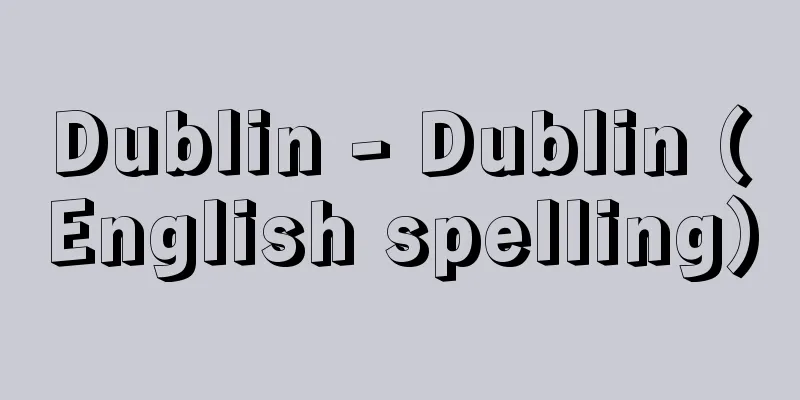Dublin - Dublin (English spelling)

|
The capital of the Republic of Ireland. It is located on the east coast of the island of Ireland, facing Dublin Bay, at the mouth of the River Liffey. In Gaelic it is called Baile Átha Cliath (meaning "impregnable fortress"), and its ancient name is Eblana. Its population is 495,101, and the metropolitan area population is 1,122,600 (2002 census preliminary figure). Approximately 80% of the population is Catholic. The central part of the city is a commercial district, and the southeast is the old town with many historical buildings. There are wide roads and squares in the city, and in the center of the city center, O'Connell Street, there is a memorial statue of O'Connell, the leader of the independence movement. In recent years, urbanization has expanded to the suburbs, and Clontarf, Donnybrook, Sandymount, Rathfarnham, Blanchardstown, and other newly developed urban areas have become major urban areas. It is now connected to the cities of Dun Laoghaire and Bray, forming the largest conurbation (interconnected urban area) in Ireland. Dublin Port was greatly improved as an international port in the early 20th century, and is connected to the Royal Canal and the Grand Canal. As a key point for inland transportation and overseas trade, it handles more than half of the country's imports and exports. Livestock, meat, dairy products, and bacon are exported, and Guinness dark beer is particularly famous and is shipped in special tankers. Coal, oil, tobacco, fertilizer, grain, chocolate, etc. are imported from Lancashire, Clydeside industrial area, Cumberland, and other parts of the UK. The sea route between the outer port of Dun Laoghaire and Holyhead in the UK (Wales) is mostly occupied by passenger ships. Industries include brewing and distilling alcohol, textiles, shipbuilding, food, foundry, glass, and tobacco manufacturing. The central plain of Ireland, where Dublin is located, is low-lying and has poor drainage, so settlements have developed on well-drained gravel layers of glacial origin, and roads run on winding eskers (embankments of glacial deposits). The warm and humid climate is suitable for growing pasture grass, but the clay soil makes it unsuitable for growing crops. Because of this, it is not possible to secure winter feed for cattle, so the plains are used as a fattening area for cattle transferred from other regions only in the summer, and the fattening cattle are shipped from Dublin. Dublin Airport is located about 20 kilometers north of the city, and it takes one hour by air to get to London. [Iwao Yoneda] historyThis area at the mouth of the Liffey River was known by the Celts as an "impregnable fortress" since ancient times, but since the Danes occupied it in the 9th century and built a walled town, it has been called "Dublin", which is the English equivalent of Black Pool (derived from the color of the water of the Liffey River). In 1172, King Henry II of England received the tribute of the Chief of Ireland on College Green, where Trinity College is now located. Since then, Dublin has been the base of British rule. Most of the Irish parliaments established by the British were held in Dublin, and the Governor's Office was also located there. Many of the historical buildings currently in the city, such as Dublin Castle (former Governor's Office), Custom House, the headquarters of the Bank of Ireland (former Parliament Building), Trinity College (University of Dublin, founded in 1592), and the Houses of Parliament (former Leinster House), were built or restored in the 18th century. It was one of the economic centers of the city, and the nationalist movement also developed here. Currently, there are statues and busts of nationalist fighters such as O'Connell and Parnell in various parts of the city. The new nationalist literary movement known as the Irish Renaissance, which took place from the late 19th century to the early 20th century, was centered around the Abbey Theatre (which burned down in 1951 and was rebuilt) on the north side of the Liffey estuary. Works by W. B. Yeats, J. M. Synge, and others raised Irish theater to a world-class standard, while J. Joyce's works attracted worldwide attention from a different perspective. Other Dublin-born writers include J. Swift, T. Moore, O. Wilde, and G. B. Shaw, as well as politicians such as E. Burke and E. Carson. [Satoshi Horikoshi] [References] |A statue of O'Connell, the leader of the independence movement, stands on O'Connell Street in the center of Dublin, the capital of Ireland. Dublin ©Shogakukan "> O'Connell Statue Source: Shogakukan Encyclopedia Nipponica About Encyclopedia Nipponica Information | Legend |
|
アイルランド共和国の首都。アイルランド島の東岸、ダブリン湾に面し、リフィ川河口に位置する。ゲール語でブラークリーアBaile Átha Cliath(「難攻不落の砦(とりで)」の意)、古称エブラナEblana。人口49万5101、首都圏人口112万2600(2002国勢調査速報値)。人口の約80%がカトリック教徒。市街地中央部は商業地域、南東部は歴史的建造物の多い旧市街である。市中には広い道路や広場があり、中心街オコネル街の中央には独立運動の指導者オコネルの記念像がある。近年都市化は郊外に拡大しクロンターフClontarf、ドニーブルックDonnybrook、サンディマウントSandymount、ラトファーンハムRathfarnham、ブランチャーズタウンBlanchardstownなどは新興の市街地となった。現在ダン・レアラやブレイなどの都市と連接し、アイルランド最大のコナベーション(連接都市地域)を形成するに至った。 国際港としてのダブリン港は20世紀初頭に大きく改良され、ロイヤル運河、グランド運河と連絡し、内陸交通、海外貿易の要衝として、同国の輸出入の半分以上を取り扱う。家畜、肉、酪農製品、ベーコンなどが輸出され、とくにギネスの黒ビールは有名で専用タンカーで船積みされる。また、イギリスのランカシャー、クライドサイド工業地帯、カンバーランドなどからは、石炭、石油、たばこ、肥料、穀物、チョコレートなどが輸入される。外港のダン・レアラとイギリス(ウェールズ)のホリヘッドを結ぶ航路はほとんど旅客船によって占められている。工業には酒類の醸造・蒸留、繊維、造船、食品、鋳物、ガラス、たばこ製造などがある。ダブリンの位置するアイルランドの中央平野は低地で水はけが悪いため、集落は排水のよい氷河起源の砂礫(されき)層上に発達し、道路は曲がりくねったエスカー(氷堆積(たいせき)物による堤防状の地形)の上を走る。気候が温暖多湿で牧草の生育に適するが、粘土質土壌であるため、農作物の栽培には不適である。このためウシの冬期飼料が確保できないこともあって、この平野は夏期だけほかの地方から転送されてきたウシの肥育地帯となり、肥育牛はダブリンから船積みされる。北郊約20キロメートルにダブリン空港があり、ロンドンと空路1時間で結ばれる。 [米田 巌] 歴史リフィ河口のこの地は古くからケルト人によって「難攻不落の砦」という意味のことばでよばれていたが、9世紀デーン人がここを占領し、城壁のある町をつくって以来、英語のブラック・プールBlack Pool(リフィ川の水の色に由来する)に相当する「ダブリン」の名でよばれるようになった。1172年イギリス王ヘンリー2世がアイルランド首長から臣従の礼を受けたのは、現在トリニティ・カレッジのあるカレッジ・グリーンであった。それ以来ダブリンはイギリスの支配の拠点となった。イギリスが開設したアイルランド議会もほとんどダブリンで開かれ、総督府も置かれた。現在市中にあるダブリン城(元総督府)、カスタム・ハウス(税関)、アイルランド銀行本店(旧議事堂)、トリニティ・カレッジ(ダブリン大学、1592創立)、国会議事堂(旧レンスター・ハウス)など歴史的な建物の多くは18世紀に建造されたり修復された。経済的にも中心都市の一つであったが、民族運動もここを中心に展開された。現在市内各所に、オコネル、パーネルなど民族運動闘士の立像や胸像がある。19世紀末から20世紀初頭にかけてのアイルランド・ルネサンスとよばれた新しい民族的文学運動は、リフィ河口北側のアベイ劇場(1951年に焼失、再建)を中心としていた。W・B・イェーツ、J・M・シングなどの作品がアイルランド演劇を世界的水準に高め、またJ・ジョイスの作品は別の視点から世界の注目を集めた。ほかにJ・スウィフト、T・ムーア、O・ワイルド、G・B・ショーなどの文学者、E・バーク、E・カーソンなどの政治家がダブリン生まれである。 [堀越 智] [参照項目] |首都ダブリンの中心オコネル街に立つ独立運動の指導者オコネルの像。アイルランド ダブリン©Shogakukan"> オコネルの像 出典 小学館 日本大百科全書(ニッポニカ)日本大百科全書(ニッポニカ)について 情報 | 凡例 |
Recommend
Akutsu Riverbank
…In addition, the Katsuri Headworks was built dow...
Interstitial inflammation
…Syphilis and fungal infections also show a form ...
systemic lupus erythematodes
…The disease is called lupus erythematosus becaus...
Interferogram
…Since δ is expressed as 2π⊿/λ using the optical ...
Embla - Embla
...The English word elm refers to the European el...
Muwatalli
…Following his father's example, he appointed...
Uematsu Arinobu
Year of death: 20th June 1910 (17th July 1813) Yea...
Tel Aviv-Yafo (English spelling)
A city on the Mediterranean coast of Israel. Popul...
Miki Rofu - Mikirofu
Poet. Real name Misao. Born on June 23, 1889 in T...
Mixture change - Mixture change
This refers to changes in efficacy, side effects, ...
Ashikari [town] - Ashikari
A former town in Ogi County, central Saga Prefectu...
Franz von Stuck
German painter and printmaker, also involved in s...
Phleum
...an annual grass of the grass family that grows...
Kahoon Papyrus - Kahoon Papyrus
…There are several medical papyri that directly s...
Machiavellianism
〘Noun〙 (Machiavellism)① A doctrine or ideology tha...









